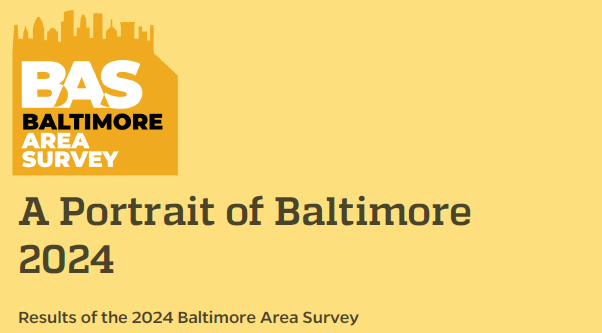
January 23, 2025
The 2024 Baltimore Area Survey (BAS) is an annual survey to measure various aspects of life among residents living in the Baltimore region. The BAS 2024 asked 163 questions of a statistically representative sample of residents who live in Baltimore City and Baltimore County. We seek to complement existing data and to fill gaps where they exist to help Baltimore-area residents, community groups, policy makers, and businesses better understand the experiences, perceptions, and attitudes of fellow residents. This, our second “Portrait of Baltimore” report, summarizes initial findings from the BAS 2024.
The survey was developed in collaboration between Johns Hopkins researchers and community leaders. It aims to help residents, community groups, policy makers and businesses better understand the experiences, perceptions, and attitudes of fellow residents over time. The responses of 1,492 Baltimore-area residents cover a variety of issues affecting the every day lives of people in the region.
The 2024 survey focused on four central topics:
- Neighborhoods and schools
- Local government services
- Food insecurity
- Connectivity and mobility
Key findings include:
Poverty Diminishes Physical and Digital Connections
Profound economic and racial inequality shape how connected Baltimore-area residents can be.
- More than two-thirds of Baltimore-area residents who made less than $30,000 experienced at least one transportation issue and less than 3 in 5 had high-speed internet in their homes.
The lack of connections physically via transportation and virtually via the internet may make receiving services, healthcare, and finding work very difficult for poorer Baltimore-area residents.
While the share of residents who experienced transportation issues slightly declined from 2023, the report showed that residents who live along the proposed Red Line were more likely to experience transportation-related issues such as skipping going places and rescheduling appointments compared to other Baltimoreans.
- 42% of Red Line residents experienced at least one transportation issue, 10 percentage points higher than residents who lived outside of the Red Line corridor.
Positive Neighborhood Perceptions
More Baltimore City residents said their neighborhoods are getting better than worse, the opposite of the sentiment seen in Baltimore County.
- 85% of Baltimore County residents reported satisfaction with their neighborhoods. Yet more of them (20%) thought things were getting worse than better (13%).
- 7 out of 10 Baltimore City residents reported being satisfied with their neighborhoods. And 28% reported improving conditions compared to 23% who saw declines.
Where everybody knows your name: 45% of city and county residents know all, most, or some of their neighbors’ names.
Trust in Government Improved
Fewer residents distrusted local government in both the city and county in 2024 compared to the previous year. Baltimore County residents trusted the government more than city residents.
- Nearly 1 out of 4 Baltimore City residents and 1 out of 3 Baltimore County residents reported trusting their local government to do the right thing most of the time.
Black Residents See Higher Quality of Schools
Compared to 2023, the share of Black Baltimore City residents who rated the public schools in their neighborhood as ‘high quality’ doubled, from 12% to 24%. Baltimore County’s Black residents also reported an increase in school quality – from a quarter of respondents in 2023 to a third of them last year.
Meanwhile, white residents in both jurisdictions barely changed their less rosy assessments of public schools – with only 13% in the city and 30% in the county reporting schools as either very good or excellent.
The declining distrust in local government and strong sense of satisfaction residents feel about their neighborhoods give local governments an opportunity to create programs that improve residents’ lives. They may choose to focus on helping Baltimore-area’s poorest residents become more connected and to work with state government to improve mobility in the region.
View the documentation and data for the 2024 survey.

